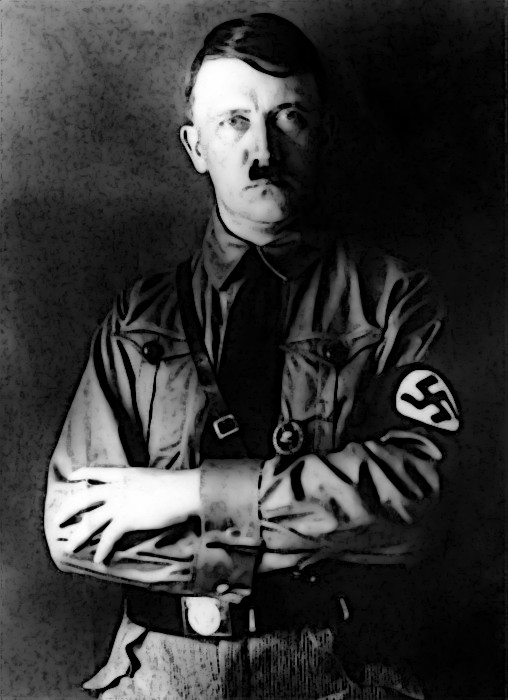Adolf Hitler

Sobriquet: Chancellor of Germany - 1933
Appearance: Adolf Hitler's trademark was his unique moustache style that formed a rectangle on top of his upper lip. He was of average build, with dark brown hair and brown eyes.
Behavior: "Hitler had charm, loved children, charmed women. But in political respects he would stop at nothing. In other respects he had soft and touching emotions. Just as he could be terribly brutal in following up political ideas, so he could be humanely sensitive for the feelings of individuals, for the individual human life." -- Wilhelm Keitel, Chief of the armed forces in Nazi Germany
History: Adolf Hitler was born on 20 April 1889 and died 30 April 1945. He was a German politician who was the leader of the Nazi Party (Nationalsozialistische Deutsche Arbeiterpartei; NSDAP), Chancellor of Germany from 1933 to 1945, and Führer ("leader") of Nazi Germany from 1934 to 1945. As dictator of the German Reich, he initiated World War II in Europe with the invasion of Poland in September 1939 and was a central figure of the Holocaust.
Hitler was born in Austria, then part of Austria-Hungary, and raised near Linz. He moved to Germany in 1913 and was decorated during his service in the German Army in World War I. He joined the German Workers' Party, the precursor of the NSDAP, in 1919 and became leader of the NSDAP in 1921. In 1923, he attempted a coup in Munich to seize power. The failed coup resulted in Hitler's imprisonment, during which time he dictated the first volume of his autobiography and political manifesto Mein Kampf ("My Struggle"). After his release in 1924, Hitler gained popular support by attacking the Treaty of Versailles and promoting Pan-Germanism, anti-Semitism, and anti-communism with charismatic oratory and Nazi propaganda. Hitler frequently denounced international capitalism and communism as being part of a Jewish conspiracy.
Recent Events: By the turn of 1933, the Nazi Party was the largest elected party in the German Reichstag, which led to Hitler's appointment, only days ago as Chancellor on 30 January 1933.
Events Soon to Occur: The Reichstag Fire Decree (German: Reichstagsbrandverordnung) is the common name of the Decree of the Reich President for the Protection of People and State (German: Verordnung des Reichspräsidenten zum Schutz von Volk und Staat) issued by German President Paul von Hindenburg on the advice of Chancellor Adolf Hitler in direct response to the Reichstag fire of 27 February 1933. The decree nullified many of the key civil liberties of German citizens. With Nazis in powerful positions in the German government, the decree was used as the legal basis for the imprisonment of anyone considered to be opponents of the Nazis, and to suppress publications not considered "friendly" to the Nazi cause. The decree is considered by historians to be one of the key steps in the establishment of a one-party Nazi state in Germany. The Enabling Act (German: Ermächtigungsgesetz) was a 1933 Weimar Constitution amendment that gave the German Cabinet – in effect, Chancellor Adolf Hitler – the power to enact laws without the involvement of the Reichstag. It passed in both the Reichstag and Reichsrat on 24 March 1933, and was signed by President Paul von Hindenburg later that day. The act stated that it was to last four years unless renewed by the Reichstag, which occurred twice. The Enabling Act gave Hitler plenary powers. It followed on the heels of the Reichstag Fire Decree, which abolished most civil liberties and transferred state powers to the Reich government. The combined effect of the two laws was to transform Hitler's government into a de facto legal dictatorship.
Should the Time-line Remain Stable: Following fresh elections won by his coalition, the Reichstag passed the Enabling Act, which began the process of transforming the Weimar Republic into Nazi Germany, a one-party dictatorship based on the totalitarian and autocratic ideology of National Socialism. Hitler aimed to eliminate Jews from Germany and establish a New Order to counter what he saw as the injustice of the post-World War I international order dominated by Britain and France. His first six years in power resulted in rapid economic recovery from the Great Depression, the effective abandonment of restrictions imposed on Germany after World War I, and the annexation of territories that were home to millions of ethnic Germans—actions which gave him significant popular support.
Hitler sought Lebensraum ("living space") for the German people in Eastern Europe. His aggressive foreign policy is considered to be the primary cause of the outbreak of World War II in Europe. He directed large-scale rearmament and on 1 September 1939 invaded Poland, resulting in British and French declarations of war on Germany. In June 1941, Hitler ordered an invasion of the Soviet Union. By the end of 1941 German forces and the European Axis powers occupied most of Europe and North Africa. Failure to defeat the Soviets and the entry of the United States into the war forced Germany onto the defensive and it suffered a series of escalating defeats. In the final days of the war, during the Battle of Berlin in 1945, Hitler married his long-time lover, Eva Braun. On 30 April 1945, less than two days later, the two killed themselves to avoid capture by the Red Army, and their corpses were burned.
Under Hitler's leadership and racially motivated ideology, the Nazi regime was responsible for the genocide of at least 5.5 million Jews and millions of other victims whom he and his followers deemed Untermenschen ("sub-humans") and socially undesirable. Hitler and the Nazi regime were also responsible for the killing of an estimated 19.3 million civilians and prisoners of war. In addition, 29 million soldiers and civilians died as a result of military action in the European Theatre of World War II. The number of civilians killed during the Second World War was unprecedented in warfare, and constitutes the deadliest conflict in human history.